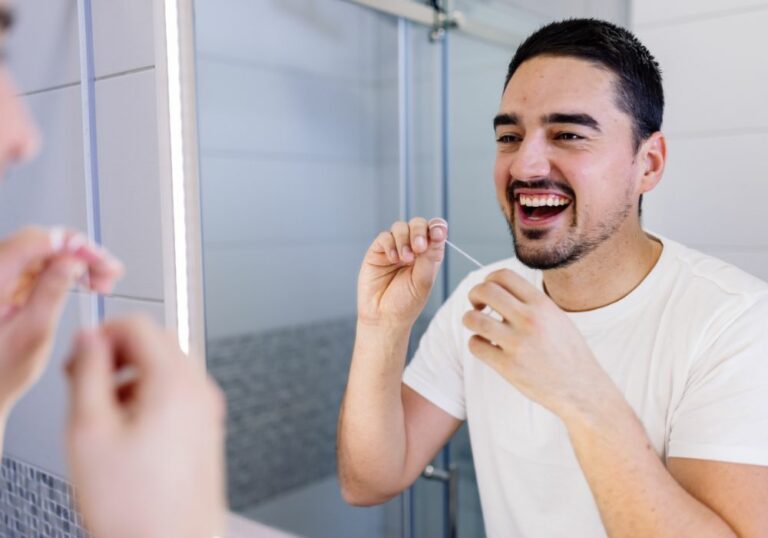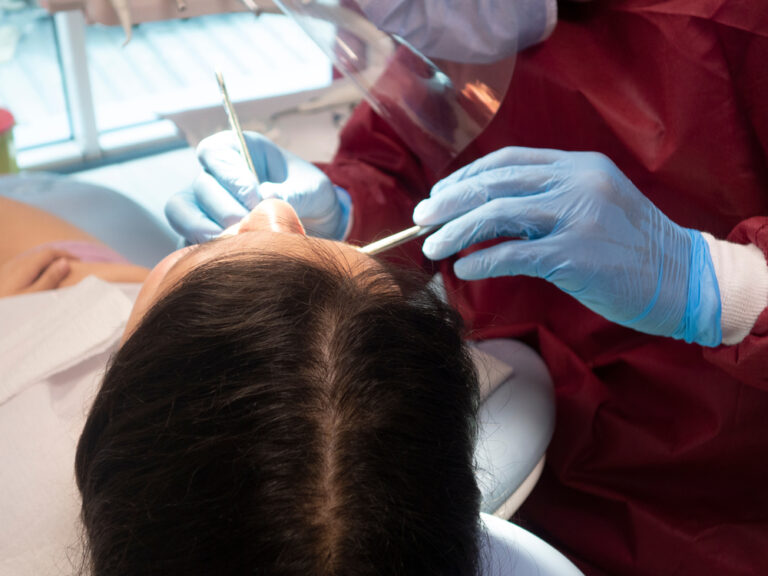Dark brown stains on your pearly whites can be unsightly and embarrassing, but what actually causes teeth to become discolored and take on a brownish tint? There are a number of contributing factors:
External Stains from Food and Drinks
The most common source of surface stains on teeth comes from consumption of certain food and beverages. These extrinsic stains develop over time when the dark pigments in foods/drinks become embedded into the microscopic grooves and pits on the enamel of your teeth:
- Coffee – Popular as a daily morning ritual for many, coffee is high in chromogens – pigments that are adept at sticking to dental enamel. With continued coffee drinking, residual pigment is left on teeth, causing yellowish to dark brown discoloration.
- Tea – Black tea, green tea, and herbal tea all contain significant amounts of tannins – water-soluble polyphenols that impart a brownish stain on teeth. Tea drinking is associated with higher enamel discoloration.
- Red wine – The deep violet pigments in red wine cling to tooth surfaces, leaving behind red-hued stains as residue. Red wine also contains acids that can erode and stain the enamel over time.
- Soda – In addition to being acidic, colas and other dark sodas contain caramel coloring that can tint and discolor the dental enamel after habitual consumption.
- Sauces & Curries – Soy sauce, tomato sauce, and the natural pigments in spices like curry and turmeric can leave behind residual stains on teeth with frequent use.
- Berries – Indigo dyes found naturally in blueberries and blackberries have an affinity for adhering to tooth enamel, which causes buildup of purple/blue-ish stains.
- Tobacco – Chewing tobacco, cigars, and cigarettes contain high levels of tar and nicotine, which cause stubborn brownish-yellow stains on teeth when smoked or chewed habitually.
Of course, an occasional indulgence in these foods and drinks typically will not cause significant staining. But over many years, heavy consumption of highly pigmented beverages and sauces/curries can lead to pronounced enamel discoloration.
Intrinsic Stains Affecting Tooth Enamel and Dentin
In some cases, the causes of brown teeth are due to intrinsic factors stemming from damage to the inner tooth structure or deficiencies that affect enamel formation and cause discoloration:
- Dental trauma – If the enamel on a tooth cracks or fractures, the yellowish underlying dentin will become exposed, creating a brownish discolored spot.
- Tooth decay – Bacterial infections that cause cavities and tooth decay can lead to accumulation of byproducts inside the dentin tubules that manifest as intrinsic brown stains.
- Aging – As we age, the outer enamel layer of our teeth naturally become thinner, allowing more of the darker yellow dentin underneath to show through. This causes gradual darkening of teeth over time.
- Genetics – Some people are born with thinner enamel or naturally more yellowish teeth, which makes them more prone to faster staining and discoloration. Enamel hypo-calcification also creates weakness.
- Medications – Certain prescription drugs are associated with causing discoloration of developing teeth in children. Notable examples are tetracycline antibiotics, which causes grey/brown banding when taken by kids under age 8. Cancer chemotherapy drugs are also linked to tooth darkening.
- Fluorosis – Excessive ingestion of fluoride during childhood can cause enamel defects including mottling, streaking, and intrinsic staining.
- Other health conditions – Dental discoloration has also been linked to disorders like congenital erythropoietic porphyria and alkaptonuria. Kidney and liver dysfunction can also affect tooth color.
Are Stains Permanent?
Given this wide range of potential causes, are tooth stains an inevitable fact of life? Can anything be done to restore stained teeth back to their original bright shade?
The good news is that nowadays, there are highly effective cosmetic treatments that can remove or mask all types of intrinsic and extrinsic brown stains, so teeth discoloration is not necessarily permanent. However, the specific treatment plan needed will depend on the original source of the staining and how deep it penetrates into the tooth structure.
Professional Teeth Whitening Options
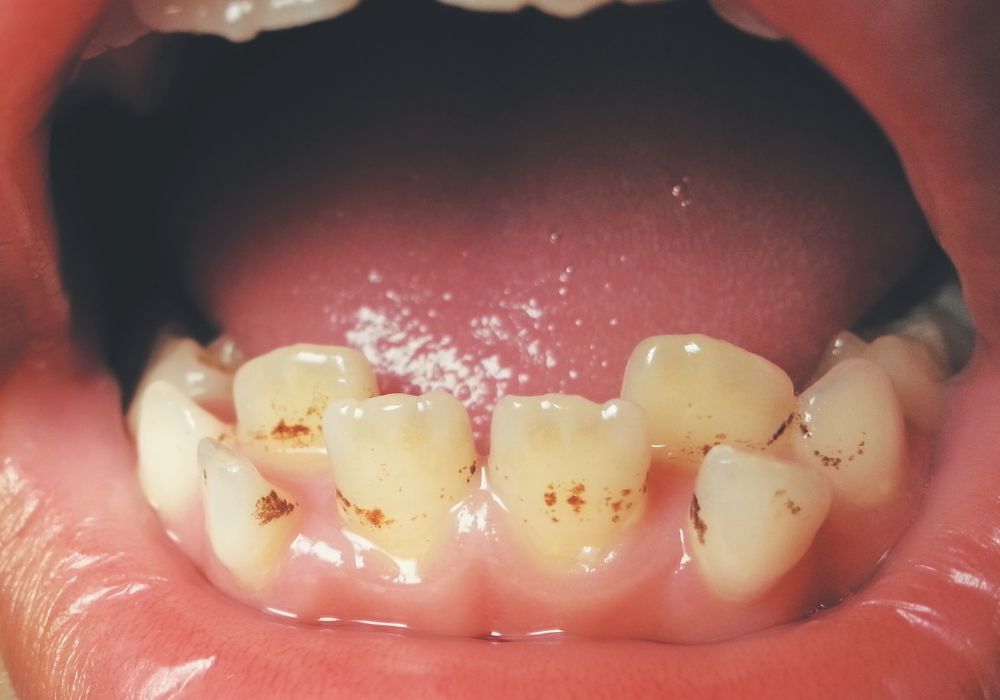
For pronounced brown staining or severe discoloration affecting most or all of your teeth, professional teeth whitening performed by your dentist is the gold standard treatment. These in-office treatments utilize concentrated bleaching gels under supervision to achieve dramatic results.
In-Office Whitening
In-office whitening typically involves applying 15-40% carbamide peroxide or hydrogen peroxide whitening gel directly to the front tooth surfaces after any debris has been cleaned off. A special curing light or laser light may be used to accelerate and maximize results. This process breaks down the dentin stains so they diffuse out of the tooth.
With in-office whitening, the average patient can experience:
- 8-10 shades of whitening after a single 30-60 minute treatment
- Less sensitivity compared to at-home whitening kits
- Faster results – lightens severely stained teeth in one visit
However, because in-office whitening only affects the stained outer enamel layer, results are not completely permanent. Re-treatment is needed periodically when discoloration recurs. On average, the benefits of in-office whitening can last 1-3 years.
Expect costs between $500-$1,000 per treatment session. Some insurance plans may offset part of the fee.
Take-Home Whitening Kits
After undergoing intensive in-office whitening, your dentist can provide customized take-home trays and lower concentration whitening gels to help you maintain the results.
These trays are worn for 1-2 hours per day over a period of weeks, with periodic touch-up treatments. On average, take-home whitening needs to be repeated every 4-6 months to keep teeth looking their brightest. Cost is typically $300-$600.
Over-the-counter whitening strips and trays from brands like Crest and GoSmile are available for home use too and cost $30-$100. However, they are not customized to fit your teeth so results are less dramatic.
Removing Superficial Surface Stains
For milder cases of external brown stains limited to the outermost enamel layer, a professional dental cleaning and polishing alone may be effective to buff away superficial discoloration so teeth appear whiter and brighter.
Procedures a dental hygienist can use include:
- Ultrasonic scaling – Uses ultrasonic vibrations to loosen staining residue on enamel.
- Air polishing – Blasting stained tooth surfaces with a fine stream of particles like sodium bicarbonate.
- Hand scaling – Manual dental scalers and curettes to mechanically debride enamel.
- Rubber polishing cups – Rotating cups with polishing paste to buff stains away.
- Fluoride therapy – High concentration fluoride applied to re-mineralize enamel.
However, these techniques only remove surface extrinsic stains, so are not effective for more severe intrinsic discoloration.
Tooth-Colored Dental Fillings and Bonding
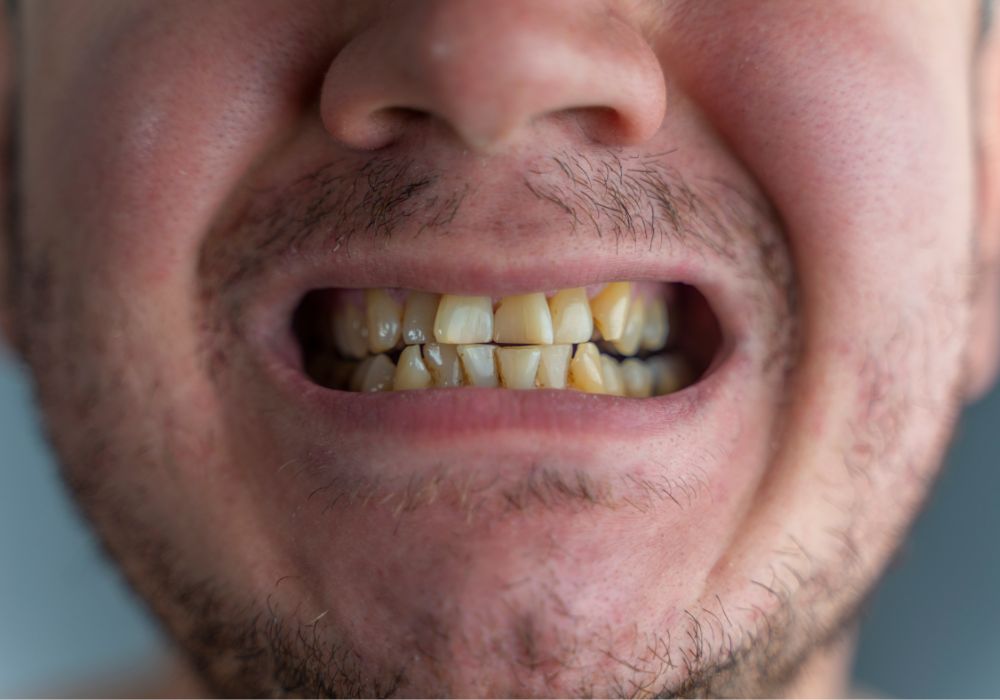
Where brown staining or darkness is limited to a single tooth, or a few isolated teeth, targeted cosmetic restorative treatments like dental fillings and bonding can effectively mask such localized discoloration:
Tooth-Colored Fillings
Traditional metal amalgam fillings are noticeable and unsightly. Today, most dentists opt to fill any cavities or defects with tooth-colored composite resin fillings because they blend in seamlessly:
- Match the exact color and shade of your surrounding natural teeth.
- Allow stained or decayed teeth to appear clean and white again.
- Require minimal removal of natural tooth structure.
- Cost effective cavity restoration method.
Dental Bonding
Bonding applies composite resin veneers to cover imperfections:
- Masks intrinsic tooth stains, including tetracycline discoloration.
- Can repair chips, cracks, and fractures on front teeth.
- Matches color/shade of adjacent teeth for discreetness.
- Less expensive alternative to dental crowns or veneers.
- Generally requires only one dental visit to complete.
While bonding only covers up stains, newer generation composites are very durable and stain-resistant. Results can last 7-10 years with proper care.
Porcelain Veneers and Dental Crowns
For the most dramatic cosmetic transformation of severely stained or discolored smiles, veneers and crowns can permanently cover darkened teeth:
Porcelain Veneers
- Thin shells of dental ceramic bonded onto front teeth.
- Completely mask and overhaul the appearance of discolored teeth.
- Customized to patient’s natural shades or desired whiteness.
- Resist staining better than natural enamel.
- Require removal of some natural tooth structure.
- Last 10-15 years but are costly – $925-$2500 per veneer.
Dental Crowns
- Encircle the entire visible portion of the tooth.
- Indicated for badly decayed or fractured teeth.
- Mask dark intrinsic stains.
- Made of sturdy porcelain, ceramic, or gold alloy.
- Require significant reshaping of the underlying tooth.
- Expensive – $800 to $1600 per crown.
Both veneers and crowns provide a permanent solution for damaged, heavily stained teeth. However, they do entail removing parts of the natural tooth, so need to be carefully planned.
Frequently Asked Questions
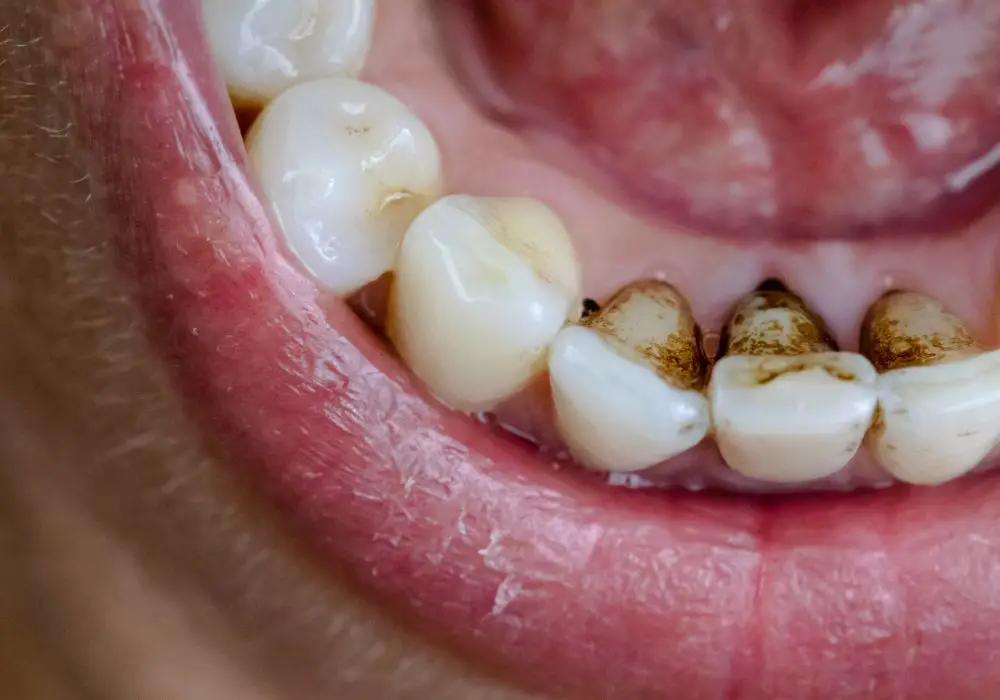
Q: What causes dark brown stains on teeth?
A: Brown tooth discoloration has many possible causes, including food/drinks like coffee and red wine, smoking, aging, genetics, antibiotics, and trauma. Stains can be either extrinsic on the enamel, or intrinsic inside the dentin layer.
Q: Can coffee stains be removed from teeth?
A: Yes – professional teeth whitening is highly effective at lightening the dark brown extrinsic stains caused by coffee, tea, and other pigmented drinks. Combining in-office and take-home whitening provides longer-lasting coffee stain removal.
Q: How do you get rid of smoking or tobacco stains?
A: Removing brownish-yellow tobacco stains requires repeated and aggressive teeth whitening treatments, since smoking causes very deep intrinsic discoloration. For a smoker, getting in-office whitening followed by custom take-home trays is recommended for stain removal.
Q: What’s the best treatment for tetracycline stained teeth?
A: Tetracycline causes greyish-brown banding deep in the tooth structure, making it one of the most challenging stains to remove. The only reliable treatment is porcelain veneers or crowns to cover the intrinsic tetracycline staining.
Q: Can a single discolored tooth be fixed with a filling?
A: Yes, for a tooth with localized, mild brown staining, getting it restored with a natural looking composite resin filling or bonding can improve its color to match surrounding teeth. This offers a conservative treatment option.
Q: How white will my teeth get with whitening treatment?
A: With professional in-office whitening, stains can be lightened by 8-10 shades for significant brightening. However, there are limits to how white teeth can get before it looks unnatural. An experienced dentist will advise on achievable results.
Conclusion
Regardless of whether brown stains on your teeth are caused by foods, smoking, medications, or other factors, today’s advanced cosmetic dentistry options offer safe, effective ways to regain a brighter, whiter smile. Professional whitening can remove both extrinsic and some intrinsic stains, while veneers, crowns, and tooth-colored fillings can mask isolated or severe discoloration. With customized treatment, even the most stubborn brown stains can be eliminated or concealed for impressive smile rejuvenation.



